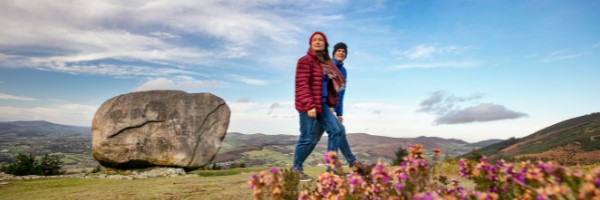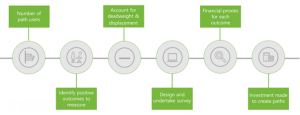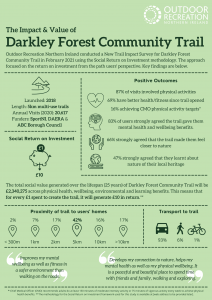
Social Return on Investment Toolkit for Trails and Greenspace
11th November 2021The importance of trails and greenspace, particularly for people’s health and wellbeing, has never been so apparent. To ensure that trails and greenspace remain high on the agenda and receive the invested warranted, the outdoor recreation sector must be able to measure the impact and quantify the value of trails and greenspace to society. Crucially then, this impact and value should be articulated in an impactful manner and in a way that understood and resonates with policymakers. For this reason, Outscape partnered with 56 Degree Insight to design and deliver an Impact Survey for new trails. A key metric within the Impact Survey is a valuation of the Social Return on Investment (SROI). A new Toolkit incorporating a User Guide, Standarised Survey and SROI valuation spreadsheet is now available for the sector to use.
Social Return on Investment Toolkit for Trails and Greenspace
(click on the icons above to access each of the toolkit items or click the links at the bottom of the page)
The need to build a strong evidence base
In recent years Outscape has taken strides to increase our knowledge and understanding of people’s participation in outdoor recreation, benefits gained, and the barriers some groups face. You can read about our population-wide research in the People, Nature and Health (2021) report and the vital role outdoor recreation plays improving health and wellbeing, protecting the environment, tackling inequality, growing and greening the economy, increasing active travel, and enhancing education and learning.
SROI is another tool for building this evidence base and at Outscape we will be using it to incorporate monitoring and evaluation for all new trails that we put on the ground. This will enable us to quantify impact and value from the perspective of the users and communicate that to stakeholders, including funders and partners.
Increasingly, the public value of investing in physical activity and the environment is being viewed through a social and economic lens (c.f., Sport England SROI research and Derry and Strabane’s Natural Capital Account). Communicating impact in simple monetary terms is a great way to show the value of what we deliver and can help us make persuasive arguments to protect and grow the resource base for outdoor recreation – meaning that we can offer more opportunities for people to be more active outdoors.
Developing a methodology and testing it at pilot sites
SROI is a standardised framework recognised by the UK Cabinet Office for measuring non-financial benefits. While it can be adapted to suit various projects, there are good practice principles that need to be adhered to:
- Involve stakeholders
- Understand what changes
- Value the things that matter
- Only include what is material
- Do not overclaim
- Be transparent
Not overclaiming and being transparent are particularly important as there is no point having a heroic SROI figure but with no explanation of how it was calculated! Therefore, for results to be credible the methodology must stand up to scrutiny.
The following methodology was adopted for 3 ‘test and learn’ pilot sites at Darkley Forest, Ballynahinch Rugby Trail, and Bunkers Hill.
- Have a way to measure user numbers – we used data from on-site people counters taken for the 12 months of 2020
- Determine what positive outcomes to measure – we included physical health benefits, mental health and wellbeing, and environmental and learning benefits
- Identify what deadweight and displacement needs to be accounted for
- Deadweight are positive outcomes which would have happened in any case (e.g., users would have gained benefits elsewhere if trail did not exist)
- Displacement are positive outcomes archived at the expense of another (e.g., if trail didn’t exist, users would take part in other activities that provide a similar positive outcomes)
- These should be subtracted from those reporting benefits
- Design and conduct survey – pilot survey had 21 questions and now revised to 15 questions
- Source financial proxies for each positive outcome – we used cost of swimming or gym session for physical health; cost of social club/group membership for mental health and wellbeing; cost of conservation holiday per hour for environmental, and; cost of outdoor education session or entrance fee to National Trust site for learning.
- Obtain the construction cost to create paths – Darkley £234,570; Bunkers Hill £132,445, and; Ballynahinch Rugby Family Trail £88,000.
Click here for detailed information on the methodology applied.
The Measuring the Value and Impact of Greenspace webinar provides information on the measures used, rationale for approach, a walk-though of the calculation for one pilot site, and the results from all 3 pilot sites.
- An overview of the pilot work completed on developing a robust impact survey and subsequent case study findings
- A thorough walk-through of the Social Return on Investment (SROI) framework adopted that provides monetary values to benefits gained by users
- An overview of a Toolkit that could be used by organisations in the sector to build up a collective body of evidence on the value and impact of trails and greenspace.
This webinar will be of interest to many, but it will be particularly relevant for staff working in Councils and eNGOs who would like to be able to measure and communicate the importance of outdoor recreation sites more effectively.
Outscape New Trail Impact Survey Guide
Outscape – SROI calculation template (please ‘save as’ if working out a valuation)


